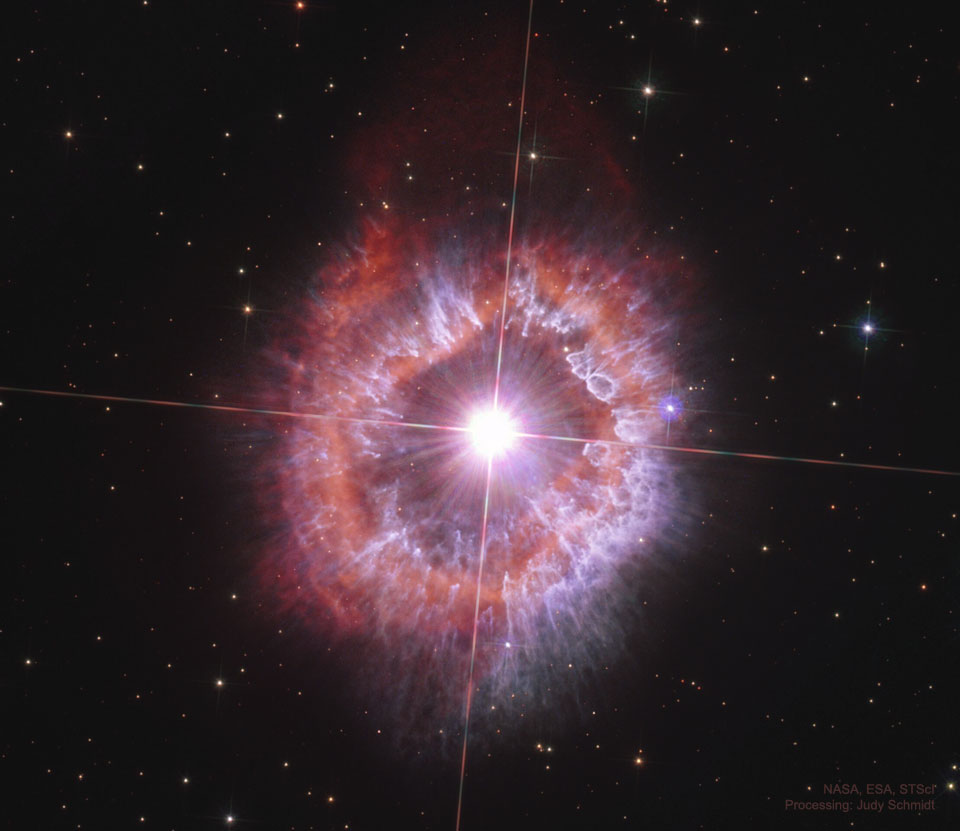Nombre total de pages vues
31/05/2021
I-PHONE ASTUCES - Secouez-moi...
ASTRONOMY - Mimas: Small Moon with a Big Crater
2021 May 31
Image Credit & Copyright: NASA, JPL-Caltech, Space Science Institute, Cassini
Explanation: Whatever hit Mimas nearly destroyed it. What remains is one of the largest impact craters on one of Saturn's smallest round moons. Analysis indicates that a slightly larger impact would have destroyed Mimas entirely. The huge crater, named Herschel after the 1789 discoverer of Mimas, Sir William Herschel, spans about 130 kilometers and is featured here. Mimas' low mass produces a surface gravity just strong enough to create a spherical body but weak enough to allow such relatively large surface features. Mimas is made of mostly water ice with a smattering of rock - so it is accurately described as a big dirty snowball. The featured image was taken during the closest-ever flyby of the robot spacecraft Cassini past Mimas in 2010 while in orbit around Saturn.
30/05/2021
29/05/2021
OVNIS - Des ovnis harcelant un navire de l’US Navy filmés sur un écran radar
ASTRONOMY - Lunar Dust and Duct Tape
2021 May 29
Image Credit: Apollo 17, NASA
Explanation: Why is the Moon so dusty? On Earth, rocks are weathered by wind and water, creating soil and sand. On the Moon, the history of constant micrometeorite bombardment has blasted away at the rocky surface creating a layer of powdery lunar soil or regolith. For the Apollo astronauts and their equipment, the pervasive, fine, gritty dust was definitely a problem. On the lunar surface in December 1972, Apollo 17 astronauts Harrison Schmitt and Eugene Cernan needed to repair one of their rover's fenders in an effort to keep the rooster tails of dust away from themselves and their gear. This picture reveals the wheel and fender of their dust covered rover along with the ingenious application of spare maps, clamps, and a grey strip of "duct tape".
27/05/2021
SANTE/MEDECINE - Attestation de vaccination
Si vous été vacciné contre la Covid-19 récemment, on vous a en principe donné à l'issue de l'injection une attestation imprimée comportant plusieurs informations (nom et prénom, type de vaccin, date de la première injection, etc.) ainsi qu'un QR Code. Code que vous pouvez utiliser pour enregistrer l'attestation dans le carnet de tests de l'application TousAntiCovid, qui centralise également les certificats de tests de dépistage. L'attestation de vaccination sera notamment utile pour le Pass sanitaire, ce "passeport" que le Gouvernement a décidé de mettre place à compter du 9 juin 2021, date de réouverture de nombreux établissements recevant du public, et qui permettra à la fois d'accéder à des manifestations et des événements regroupant plus de 1 000 personnes (spectacles, festivals, rencontres sportives, parcs à thèmes, foires, salons, etc.) et à faciliter le passage des frontières, pour les voyages professionnels ou les vacances (pour en savoir plus sur le Pass sanitaire, consultez la page de questions-réponses sur le site Web du Gouvernement).
ASTRONOMY - The Outburst Clouds of Star AG Car
2021 May 26
Image Credit: NASA, ESA, STScI; Processing: Judy Schmidt; Text: Anders Nyholm
Explanation: What created these unusual clouds? At the center of this 2021 Hubble image, processed by Judy Schmidt, sits AG Carinae, a supergiant star located about 20,000 light-years away in the southern constellation Carina. The star's emitted power is over a million times that of the Sun, making AG Carinae one of the most luminous stars in our Milky Way galaxy. AG Carinae and its neighbor Eta Carinae belong to the scarce Luminous Blue Variable (LBV) class of stars, known for their rare but violent eruptions. The nebula that surrounds AG Car is interpreted as a remnant of one or more such outbursts. This nebula measures 5 light-years across, is estimated to contain about 10 solar masses of gas, and to be at least 10,000 years old. This Hubble image, taken to commemorate Hubble's 31st launch anniversary, is the first to capture the whole nebula, offering a new perspective on its structure and dust content. The LBVs represent a late and short stage in the lives of some supergiant stars, but explaining their restlessness remains a challenge to humanity's understanding of how massive stars work.
25/05/2021
ASTRONOMY - The Moon During a Total Lunar Eclipse
2021 May 25
Video Credit: Wang Letian & Zhang Jiajie
Explanation: How does the Moon's appearance change during a total lunar eclipse? The featured time-lapse video was digitally processed to keep the Moon bright and centered during the 5-hour eclipse of 2018 January 31. At first the full moon is visible because only a full moon can undergo a lunar eclipse. Stars move by in the background because the Moon orbits the Earth during the eclipse. The circular shadow of the Earth is then seen moving across the Moon. The light blue hue of the shadow's edge is related to why Earth's sky is blue, while the deep red hue of the shadow's center is related to why the Sun appears red when near the horizon. Tomorrow, people living from southeast Asia, across the Pacific, to the southwest Americas may get to see a Blood Supermoon Total Lunar Eclipse. Here the term blood refers to the (likely) red color of the fully eclipsed Moon, while the term supermoon indicates the Moon's slightly high angular size -- due to being relatively close to the Earth in its slightly elliptical orbit.
PRATIQUE - Ouvrir une boîte de conserve sans ouvre-boîte
ASTRONOMY - 2025 September 7
2025 September 7 All the Water on Planet Earth Illustration Credit: Jack Cook, Adam Nieman, Woods Hole Oceanographic Institution ; Data s...

-
2022 September 26 All the Water on Planet Earth Illustration Credit: Jack Cook, Adam Nieman, Woods Hole Oceanographic Institution ; Data ...
-
2021 August 11 Mammatus Clouds over Saskatchewan Image Credit & Copyright: Michael F Johnston Explanation: When do cloud bottoms appe...






